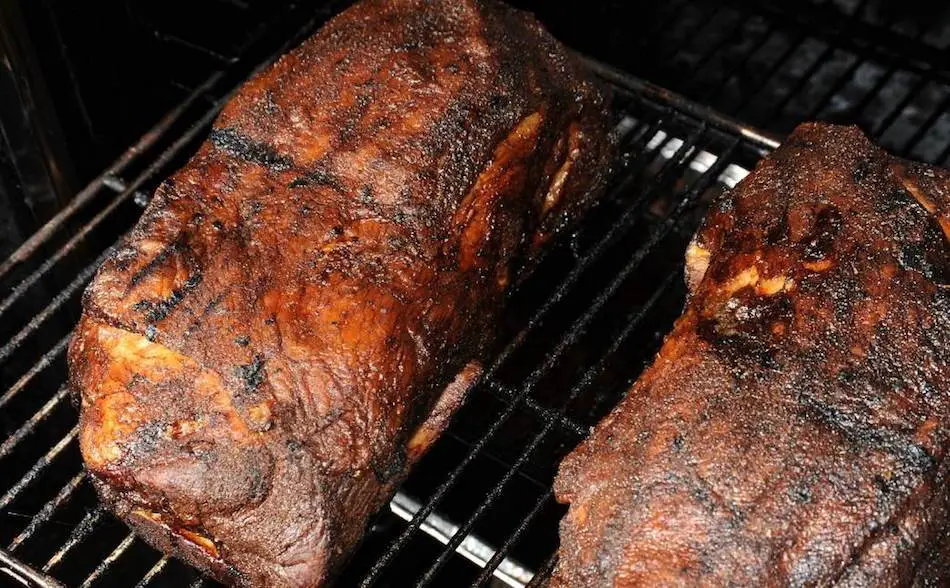
The secret to the perfect pulled pork lies in the cooking temperature. Whether you’re new to smoking or a seasoned pitmaster, mastering the art of temperature control is crucial for achieving tender, juicy, and flavorful pulled pork. In this article, we dive deep into the world of barbecue to uncover the techniques used by the pros. We’ve done the research so you don’t have to, and we’re sharing all our findings with you, so you can enjoy tender, juicy pulled pork every time.
The key to achieving tender and juicy pulled pork is to master the art of temperature control during the smoking process. The ideal temperature range for smoking pulled pork is between 225° F to 250° F, with the option to cook at a higher temperature for faster cooking. Pork butt or shoulder is the recommended cut of meat for pulled pork due to its high fat and connective tissue content, which require low temperatures and long cooking times to break down and achieve the desired tenderness. The total cook time is determined by the weight of the pork shoulder and the cooking temperature, and it’s important to use an internal thermometer to ensure it has reached the optimal temperature of around 200° F.
Pork Butt Times and Temperatures by Weight
The below table is an approximation and the actual cooking time can vary depending on the specific cut of pork, the equipment used, and personal preference.
| Weight (lbs) | Temperature (°F) | Cook Time (hours) |
|---|---|---|
| 6 | 225 | 8-10 |
| 8 | 225 | 10-12 |
| 10 | 225 | 12-14 |
| 6 | 250 | 6-8 |
| 8 | 250 | 8-10 |
| 10 | 250 | 10-12 |
| 6 | 275 | 5-7 |
| 8 | 275 | 7-9 |
| 10 | 275 | 9-11 |
| 6 | 300 | 4-6 |
| 8 | 300 | 6-8 |
| 10 | 300 | 8-10 |
| 6 | 350 | 3-5 |
| 8 | 350 | 5-7 |
| 10 | 350 | 7-9 |
What the Experts Say
Please note that these are just examples, and the pitmasters may use different temperatures or methods depending on the specific cut, competition, or event.
| Pitmaster | Pork Shoulder | Ribs | Brisket |
|---|---|---|---|
| Myron Mixon | 225-250°F | 225-250°F | 225-250°F |
| Tuffy Stone | 225-250°F | 225-250°F | 225-250°F |
| Aaron Franklin | 300°F | 300°F | 250°F |
| Chris Lilly | 225-250°F | 225-250°F | 225-250°F |
| Ed Mitchell | 250°F | 250°F | 250°F |
How Long Per Pound?
Cooking a pork butt will take about 1 hour per pound or 1.5 hours per pound depending on the temperature of your smoker. The total cook time is determined by the weight of the pork shoulder, and the cooking temperature, so it’s difficult to predict how long it will take.
In general, it takes around about 8 hours to cook the average sized pork shoulder for pulled pork. The average book should always be about 6 to 10 lbs, and you’re better off using a pork shoulder with a bone. The bone in will help keep the roast moist and it also serves as a handy tenderness test towards the end of the cook. If you want full off the bone tender, juicy pork shoulder, then the bone is a handy tool where you can twist it at the end of your cook.
“When it comes to pulled pork, low and slow is the name of the game. Cook it at a low temperature for a long time and let the smoke do its magic.”
– Myron Mixon, pitmaster and BBQ expert
Smoking Pulled Pork at 225° F
The standard temperature for cooking a pork shoulder is 225° F. The maximum temperature is 275° F. If you can keep it within this range, won’t dry out. As long as you cook it, to you the ideal serving temperature (which is around about 200° F.)
225°F is considered the standard low-and-slow temperature for smoking meat like pulled pork because it allows for the meat to cook slowly over a long period of time, allowing the flavors from the smoke to penetrate the meat and for the connective tissues to break down, resulting in a tender and flavorful final product. Also, cooking at a low temperature helps to prevent the exterior of the meat from becoming too tough or burnt.
When is Pork Butt Done?
- Pork butt should be cooked to an internal temperature of around 200°F because at that temperature, the collagen in the meat begins to break down and turn into gelatin, which helps to make the meat tender and juicy. -The safe internal temperature for pork butt is 145°F (63°C) as measured by a food thermometer. -Most BBQ enthusiasts and pitmasters like to cook pork butt to around 190-203F (88-95C) for a more tender and juicy meat. -Meat should be tender enough to pull apart easily and ideal for dishes like pulled pork sandwiches. -It’s important to allow the pork to rest for at least 3 minutes before cutting or consuming to allow the heat to distribute evenly.
Cook the pork butt until it reaches an internal temperature of around 200° F. Perform a tenderness test on the pork by poking a toothpick into the meat. It should feel as though you are poking a stick of butter.
Pork butt, also known as Boston butt or shoulder, is typically cooked to an internal temperature of 200°F because at that temperature, the collagen in the meat begins to break down and turn into gelatin, which helps to make the meat tender and juicy. The safe internal temperature for pork butt, or any pork, is 145°F (63°C) as measured by a food thermometer.
However, the meat would be too tough to eat at this temperature. pork butt to a higher internal temperature. Most BBQ enthusiasts and professional pitmasters like to cook pork butt to around 190-203F (88-95C) because at this temperature, the meat is more tender and juicy. When pork butt is cooked to 200°F, the meat should be tender enough to pull apart easily, making it ideal for dishes like pulled pork sandwiches. This is because at this temperature the connective tissue in the meat is broken down, and the fat is rendered, which makes the meat more flavorful.
It’s important to allow the pork to rest for at least 3 minutes before cutting or consuming to allow the heat to distribute evenly.
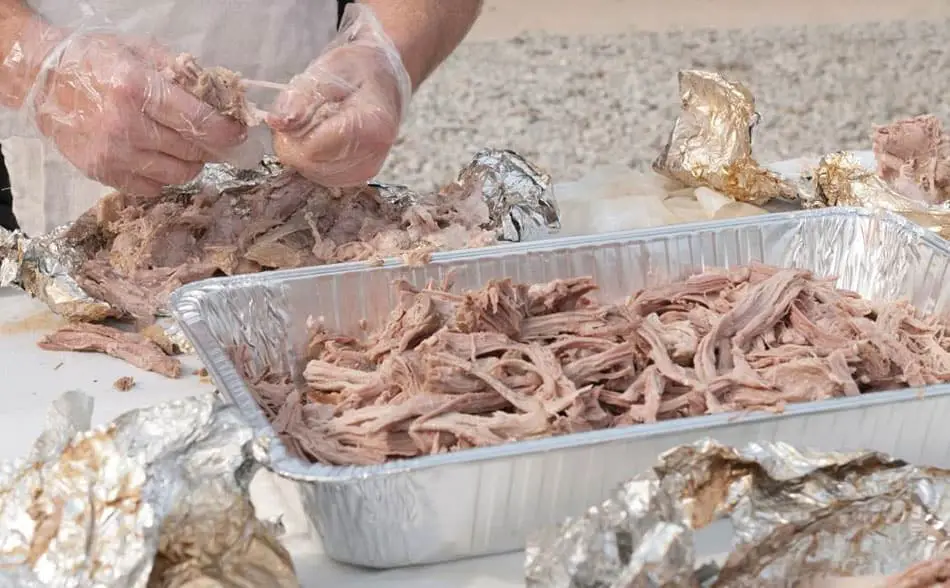
The Bark
One of the best features of a smoked shoulder is the bark. When shredding pork, you want to have some crispy meat mixed through. Bark gives a nice texture to your pulled pork. You want to have a little of crunch mixed in with the tender, juicy meat.
The bark is the flavorful, crusty exterior that forms on the surface of meats like pork butt when they are smoked. The formation of bark is the result of a complex interplay of chemical and physical processes that occur during the smoking process.
When meat is exposed to smoke and heat, the surface of the meat begins to dry out and form a crust. This crust is formed by the evaporation of moisture from the surface of the meat, which causes the proteins and carbohydrates in the meat to react and form new compounds. As the surface of the meat continues to dry out, the crust becomes increasingly hard and flavorful.
During this process, the smoke from the wood also deposits various compounds like smoke flavor, color and some phenols on the surface of the meat. These compounds interact with the meat proteins, lipids and carbohydrates to create a unique flavor profile and color.
Additionally, the Maillard reaction, which is a chemical reaction between amino acids and reducing sugars, takes place on the surface of the meat. This reaction gives the bark its characteristic brown color and adds a depth of flavor to the meat.
The final result of this process is a bark that is rich in flavor, with a complex mixture of smoky, sweet, and savory notes. It also provides a great texture contrast to the tender meat inside.
It’s important to note that the formation of bark on pork butt or other meats is affected by factors such as temperature, humidity, cooking time, type of wood used for smoking, and the amount of time the meat is exposed to smoke. Pitmasters often have to adjust the conditions in the smoker to get the desired bark formation.

Low Temp Means More Tender
- -Cooking pork shoulder low and slow results in more flavor and retained moisture, making for a more tender final product.
- -The connective tissue and collagen in the meat break down over time and low temp, forming a gelatin-like texture.
- -Cooking at low temperatures, such as 225°F (107°C), allows for a slow breakdown of collagen, resulting in a tender final product
- -Fat in the meat also melts and lubricates the meat, adding to the overall tenderness
- -Cooking time also plays a role in the tenderness of the meat.
- -It’s important to note that biological changes also happen in the meat, like the denaturation of myosin and actin, resulting in a more tender meat.
The reason you want to cook your pulled pork low and slow is so that you get more flavor and you retain moisture. It also helps with its overall texture of the meat. The last thing you want is dry stringy pulled pork.
Pork shoulder is tough and contains a lot of fat and connective tissue, so it needs time and low temperatures in order to break down. Once all the connective tissue breaks down, it forms a gelatin-like texture and makes the meat taste delicious and tender and juicy.
Pork shoulder contains a large amount of collagen, and if you were to cook it fast, it would make the pulled pork taste all chewy.
Tough cuts of meat like pork butt, also known as Boston butt or shoulder, become tender when cooked at low temperatures over a long period of time through the process of collagen breakdown. Collagen is a fibrous protein that makes up a large portion of connective tissue in meats like pork butt.
When meat is heated, the collagen begins to break down and turn into gelatin, which is a much softer protein. The rate at which collagen breaks down into gelatin is temperature-dependent, meaning that the lower the temperature, the slower the process will be. Cooking at a low temperature, like 225°F (107°C) allows for the collagen in the meat to break down slowly over a long period of time, resulting in a tender final product.
Also, as the meat cooks, the fat inside the meat begins to melt and can also help to lubricate and moisten the meat, making it more tender.
As well as collagen breakdown, other biological changes happen in the meat when cooked low and slow. The myosin and actin proteins in the meat denature (unwind) and form a gel, this can also contribute to the tenderness of the meat.
It’s important to note that cooking time will also be a factor in the tenderness of the meat, as it takes a longer time to break down collagen at low temperatures, the meat needs to be cooked longer. This is why pulled pork is often cooked for several hours to achieve the desired level of tenderness.
Low Temp Equals More Smokey
- -Cooking at low temperatures, like 225°F (107°C), allows for more time for the smoke to penetrate the meat and infuse it with flavor.
- -Low temperatures dry out the surface of the meat more slowly, allowing more time for smoke to stick and infuse flavor.
- -Low temperature also allows smoke particles to be retained on the meat surface longer, resulting in more smoke flavor.
- -Different types of wood used for smoking can also affect the smokiness of the meat.
- -The pitmasters often use woods like hickory, mesquite, and oak to achieve a strong smoky flavor, while fruitwoods like apple and cherry will give a sweeter flavor.
The other advantage of cooking at a low temperature is the meat gets to spend more time absorbing smoke. If you were to cook the pork roast fast, it will not have enough time in the smoker.
When meat is cooked at low temperatures, like 225°F (107°C) , the smoke has more time to penetrate the meat and infuse it with flavor. At higher temperatures, the meat cooks faster, which means that there is less time for the smoke to interact with the meat.
Also, at low temperatures, the surface of the meat will dry out more slowly, which means that the smoke will have more time to stick to the surface of the meat and impart its flavors. At higher temperatures, the surface of the meat will dry out more quickly, which means that the smoke will not have as much time to stick to the surface of the meat.
Another reason why low temperatures make meat smokier is that at low temperature, the smoke particles are not dissipated as quickly as they are at high temperatures. Since the smoke particles are not dissipated, they have a longer time to interact with the meat and will be able to infuse more of the smoke flavor.
Also, when meat is cooked at low temperatures, it releases less moisture and less heat and the smoke particles can be retained on the meat surface longer and thus the meat can absorb more smoke flavors.
Keep in mind that different woods will impart different flavors to the meat. Pitmasters usually use woods like hickory, mesquite, and oak to get a strong smoky flavor, while fruitwoods like apple and cherry will give a sweeter flavor. The type of wood used for smoking can also affect the smokiness of the meat.
“One of the keys to great pulled pork is to not rush it. Take your time and let the pork cook until it’s fall-apart tender.”
– Tuffy Stone, pitmaster and competition BBQ champion
Two-Zone Cooking
- -Cooking pulled pork with indirect heat, rather than over direct heat, creates a hot and cool zone for efficient low-and-slow barbecue cooking.
- -The heat source is separated from the meat by a barrier, such as a water pan or deflector plate.
- -The cool zone is used for slow-cooking the meat at a consistent and controlled rate of around 225-250F (107-121C).
- -A water pan in the cooker helps to regulate temperature and humidity, keeping the meat moist and preventing it from drying out. -The hot zone is used to quickly sear the meat, creating a flavorful crust and sealing in juices.
- -Allows pitmasters to have more control over cooking process and achieve desired level of tenderness and smokiness.
- -Efficient use of fuel, as meat can be cooked over a longer period of time without constant adjustments to heat source.
- -Method may vary depending on type of cooker or grill used.
When cooking pulled pork, it’s important to cook with indirect heat, rather than over any direct heat. If you are using a kettle grill, place the coals on one side of the smoker and cook the meat on the other side. This is also sometimes called two-zone cooking where you create a hot-zone and a cool-zone.
Two-zone cooking, also known as indirect cooking, is a technique used in low-and-slow barbecue cooking where the heat source is separated from the meat by a barrier, such as a water pan or a deflector plate. This technique is used to create two distinct temperature zones in the cooker: a hot zone for searing the meat and a cool zone for slow-cooking the meat.
When meat is placed in the cool zone of the cooker, it is not directly exposed to the heat source. Instead, it is cooked by the radiant heat that is emitted by the hot coals or the walls of the cooker. This allows for the meat to cook at a more consistent and controlled rate, as the temperature in the cool zone is usually around 225-250F (107-121C), which is ideal for low-and-slow cooking.
The use of a water pan in the cooker can also help to regulate the temperature and humidity in the cooker. Water vaporizes at 212F (100C) and the steam created by the water pan can help to keep the meat moist and prevent it from drying out. Additionally, the water pan can act as a heat sink, absorbing and distributing heat more evenly throughout the cooker.
The hot zone, on the other hand, is used to quickly sear the meat, which helps to create a flavorful crust on the surface of the meat, known as the bark. Searing the meat in the hot zone also helps to seal in the juices and add more flavor to the meat.
Two-zone cooking allows pitmasters to have more control over the cooking process and to achieve a desired level of tenderness and smokiness in the meat. It also allows for more efficient use of fuel, as the meat can be cooked over a longer period of time without the need for constant adjustments to the heat source.
Two-zone cooking may vary depending on the type of cooker or grill you are using, and some pitmasters may use different methods to create the hot and cool zones.
“Brisket vs Pulled Pork: Which One Reigns Supreme?”
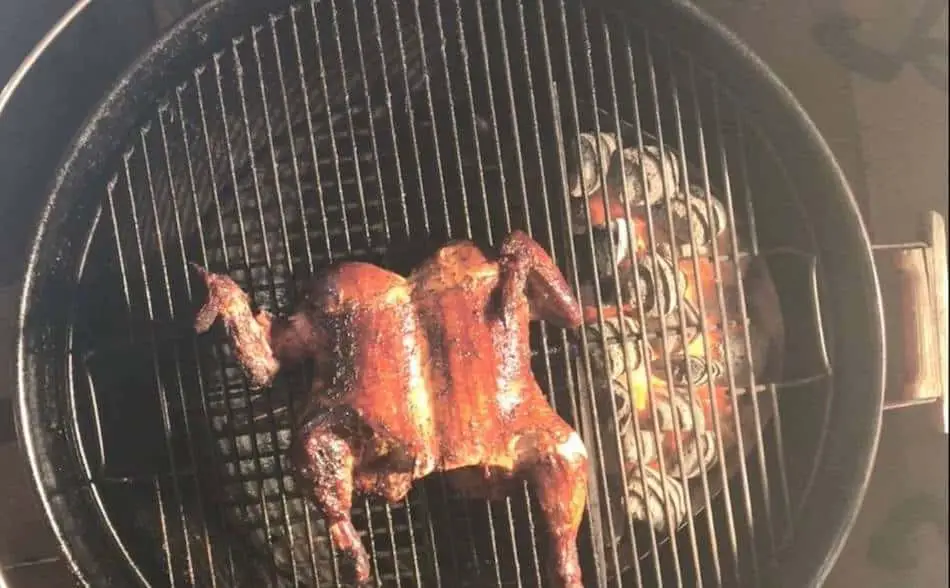
Keep it Low and Slow
Low and slow cooking is all about cooking to temperature, not time. Traditional roasting recipes will usually will tell you to cook a roast for X amount of hours per pound. This is not how we want to cook our pork roast for pulled pork. We want to be more precise. The most important tool for slow cooked barbecue is a meat thermometer. The idea is to cook to internal meat temperature rather than time. So it’s difficult to give an exact answer as to how long meat takes to cook. It takes as long as it takes. The meat is done as soon as it reaches the target internal temperature.
How Long Will it Take to Make Pulled Pork in a Smoker?
A standard pork butt weighing around about 6 lb should take 8 or 9 hours if cooked at 225° F. If you were to cook the same roast at 275° F, then it will be done one hour or two hours sooner. The total cook time also depends on whether you wrap the meat in aluminium foil. If you choose not to wrap the meat at the halfway point, then expect to add on an extra hour to the total cook time. Wrapping will speed up the cook, but creating a steam and shaving one hour of the total cook time.
“You can’t rush barbecue. Cooking a pork shoulder low and slow is the only way to get that tender, juicy meat that just falls apart in your mouth.”
– Aaron Franklin, pitmaster and owner of Franklin Barbecue
What Temp Does Aaron Franklin Smoke Pork Butt?
When smoking pulled pork, barbecue master Aaron Franklin cooks his pork butts at 275° F. You probably don’t want to go any higher than 275, because you will put the book at risk of drying out.
“When To Wrap Pulled Pork – Timing Is Everything”
Should You Spritz Pulled Pork?
Spritz the pork butt with apple cider vinegar or apple juice in a spray bottle. Leave a pork butt alone for the first 3 or 4 hours, but prior to wrapping, spritz every 40 minutes to an hour just to prevent charring on the outside or underneath the pork.
“The secret to great pulled pork is patience. Allow plenty of time for the smoke to penetrate the meat and for the pork to cook to perfection.”
– Chris Lilly, pitmaster and competition BBQ champion
When to Spritz?
Don’t spritz too early, otherwise you will wash off the seasoning. Check the pork prior to spritzing and touch it with your finger. If any of the seasoning sticks to your finger, then it’s too soon to spritz.
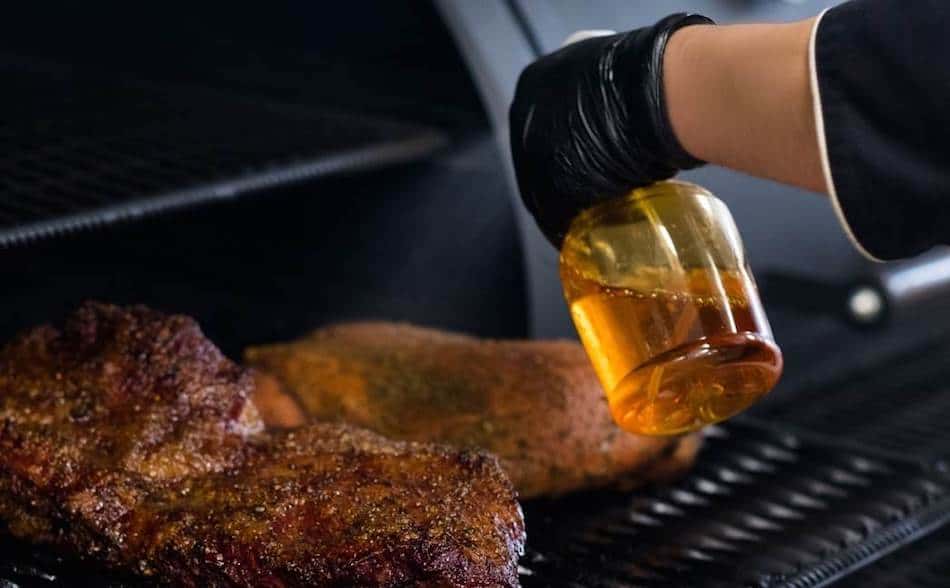
When to Wrap Your Pulled Pork?
Timing is everything when it comes to wrapping your pork butt for pulled pork. If you wrap too soon, it’s not going to have as much flavor, and the texture of the bark will not have a crunch. If you wrap too late, then your meat is at risk of drying out, getting over exposure to smoke, and so many other variables.
The best time to wrap your pork butt is once the bark has set, and you will notice cracks emerging. Once you see these signs, it’s time to wrap. Also, have a look at the color, it should be a dark mahogany.
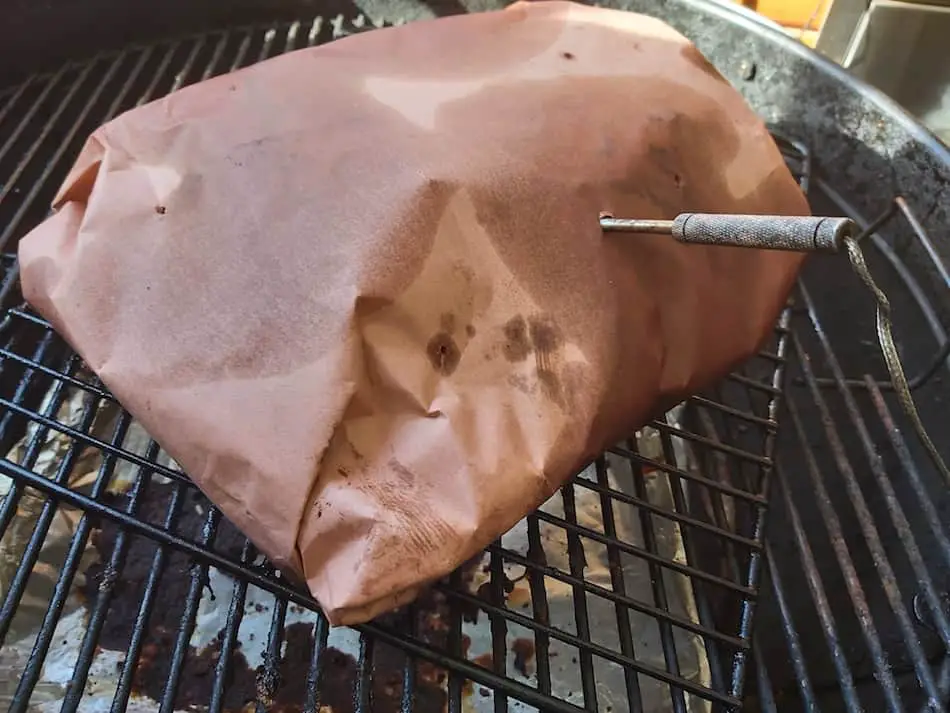
Rub snd Seasoning
The best rub for pulled pork is Killer Hogs or Harry Soo’s Slap Yo Daddy. There are dozens of rubs on the market, but I found these to be the best because they are made by champion pitmasters.
Standard Barbecue Rub

I found this great rub recipe through How To BBQ Right. I use this recipe and alter it slightly depending on what I'm cooking. Made by the guys at Townsend Spice & Supply: https://townsendspice.com/
Ingredients
- - ½ Cup Paprika
- - ½ Cup Salt
- - ½ Cup Sugar
- - ½ Cup Granulated Garlic
- - ¼ Cup Granulated Onion
- - ¼ Cup Chili
- - ¼ Cup Cumin
- - 2 Tablespoons Black Pepper
- - 2 Tablespoons Dry Mustard
- - 1 Tablespoon Cayenne Pepper
Instructions
- Combine all the spices together in a large mixing bowl
- Store rub in rub shakers
Texas Style Rub
If you want to keep things really simple, just do an Aaron Franklin style rub with a coarse black pepper and kosher salt. Franklin will often add in a little of paprika for color, a bit of granulated onion and garlic powder to hit some savory tones. For more information on Texas-style rubs, check out this article.
“Pulled Pork Sliders – (How To Smoke a Pork Butt For Sliders)”
Apply a Binder
I find it’s best to put a binder on the pork butt prior to adding the rub. Slathering the pork with either olive oil or yellow mustard will help the rub stick to the meat, which will prevent you from having a patchy bark.
“The key to great pulled pork is using a good quality cut of meat and cooking it slowly over low heat until the meat is fork-tender.”
– Ed Mitchell, pitmaster and BBQ expert
Let it Rest
- -Resting pork shoulder for 1 hour before shredding allows the muscles to relax and reabsorb moisture.
- -Resting period allows juices in the meat to redistribute evenly, resulting in a more moist and flavorful final product.
- -During resting, the temperature inside the meat will continue to rise, known as carryover cooking, which can make the meat more tender and kill bacteria.
- -Resting time can vary depending on the size and thickness of the meat, usually ranges from 15 to 45 minutes.
- -Wrapping the meat in foil or butcher paper can trap moisture and create a steaming effect, further breaking down connective tissue and making the meat more tender.
You want to allow about 1 hour to rest the pork prior to shredding. You need to allow time for the muscles to relax, because they tighten during the cook and keep pushing out moisture. Resting allows the muscles to reabsorb some of that moisture. If you were to slice and shred it directly out of the smoker, it’s got to lose all the moisture within minutes and the pulled pork will be dry.
The resting period allows the juices in the meat to redistribute evenly throughout the meat, which can make the meat more moist and flavorful. When meat is cooked, the juices in the meat are forced to the center of the cut. If the meat is cut immediately after cooking, the juices will pour out, resulting in dry meat. By allowing the meat to rest, the juices have time to redistribute throughout the meat, resulting in a more moist and flavorful final product.
Also, during the resting period, the temperature inside the meat will continue to rise, this is known as carryover cooking. This can help to make the meat more tender and can also help to kill any bacteria that may be present in the meat.
The resting time can vary depending on the size and thickness of the meat, but usually, it ranges from 15 to 45 minutes. Some pitmasters will also wrap the meat in foil or butcher paper to trap the moisture and create a steaming effect, which can help to break down the connective tissue, making the meat more tender.
Not Ready To Eat? Place the Pork into Holding
If you’re not ready to serve, please the pork in a dry cooler where it will stay hot for hours. If you are placing into a cooler, keep the pork in its aluminium foil and wrap it again in a towel. Leave the thermometer inserted into the meat, so you can monitor the internal temperature. As long as it doesn’t dip below 140° F, it’s safe in the cooler for several hours.

How to Shred for Pulled Pork
I find using your hands is the best way to shred your pulled pork. Either use heat proof gloves, or wait until the pork has cooled down before shredding. Your other option is to use Bear Claws to pull apart your pork.
It’s very important to only slice or shred what you need. However, if you’re confident, you’ll use all the pulled pork in one serving, then shred the entire pork. If you plan on having leftovers, they are much better kept in a peace rather than shredded. That way, if you want to have pulled pork the following day, it’s going to be much better.
According to pitmasters, there are several ways to shred pulled pork:
- Pulling with forks: This method involves using two forks to pull the meat apart. Pitmasters will insert the tines of the forks into the meat and then use a twisting motion to shred the meat. This method is often used when the meat is still hot and is considered one of the most effective methods for shredding pulled pork.
- Pulling with meat claws: Meat claws are specially designed tools that are used to shred meat. Pitmasters will use the claws to grip the meat and then pull it apart. Meat claws are ideal for shredding large amounts of meat quickly and with minimal effort.
- Chopping with a knife: This method involves using a sharp knife to chop the meat into small pieces. Pitmasters will slice the meat against the grain to make it more tender, then chop the slices into small pieces. This method is often used when the meat has cooled and is considered the most traditional method for shredding pulled pork.
Can You Smoke Pulled Pork Overnight?
The overnight cook is common in the barbecue community, however, it carries some risks. I personally couldn’t sleep knowing there was a potential fire waiting to happen. Even my so-called set and forget pellet smoker has issues sometimes. I’ve had with backburns in the hopper. The only smoker I would feel comfortable leaving overnight would probably be an electric smoker. Many charcoal smokers have the potential to start grease fires, etc.
If you choose to do the overnight cook, make sure you’ve got a good wireless remote thermometer to keep a close eye on the temperature of your smoker and your meat. You want to have good alarms so that you can wake up if the smoker is going outside your set parameters.
How to Avoid Dry Pulled Pork
There’s nothing worse than dry, pulled pork. To guarantee tender, juicy pulled pork, smoke within the 225 to 275° temperature range. Make sure your wrap the pork at the halfway point, which will help retain the moisture. You can spritz the pork at several stages, which will also help the mate remain moist.
Resting is probably one of the most important factors in getting excellent results, because the meat will dry out if you don’t allow adequate resting time.
Also shred the pork closer to serving, because as soon as you thread it’s going to lose a lot of moisture. You can pre brine the park, which will help retain some of the moisture during the cook. Use a dry brine, rather than a wet brine, by applying kosher salt to the meat and allowing it to rest overnight or 2 hours prior to cooking.
Importantly, use good thermometers to track the internal temperature of the pork. You don’t want to overcook it, you only want to leave it in the smoker until it reaches the internal temperature of 200° F.
| Cause of dry pulled pork | Solution |
|---|---|
| Cooking at too high of a temperature | Lower the cooking temperature and cook for a longer period of time |
| Cooking for too long | Monitor the pork’s internal temperature and remove it from the heat once it reaches between 195°F and 200°F. |
| No salt | Salting, or brining the pork will help the meat retain moisture during the long, slow cook. |
| Lean meat | Choose cuts with higher fat content for juiciness and flavor. |
| Dry cooking environment | Baste or spritz during the cook to add moisture to the cooking chamber. |
| No water pan | Keep the water pan full to add moisture to the cooking environment. |
| No wrapping | Wrap the pork for the last phase of the cook. Wrap one the meat has reached 150°F to 160°F |
| Not allowing the meat to rest before shredding | Let the meat rest for at least 15 minutes before shredding to reabsorb its juices |
| Over Shredding | Only shred what you need. Don’t shred the entire roast. |
| Frozen meat | Frozen meat tends to dry out easier than fresh pork. |
My Favorite Meat Smoking Tools
Thanks for checking out this article. I hope you learned a few things. Here are some of my favorite tools I use when smoking brisket that may be useful to you. These are affiliate links, so if you decide to purchase any of these products, I’ll earn a commission. But in all honesty, these are the tools I recommend to my family and friends who are just starting out.
Meat Thermometer: There are dozens of fancy thermometers on the market, but I still use my trusty TP20. For around $50, I have a high-quality meat thermometer with two probes, and can track the temperature of my smoker with one probe, and my meat with the other probe. The ThermoPro TP20 is an Amazon Best Seller because it’s the easiest thermometer to operate, is durable, highly accurate, and comes with pre-programmed meat settings.
Instant Read Thermometer: Arguably, the second most important tool you need is a fast and accurate instant-read thermometer. These tools play an important role in the latter stages of the cook when the meat needs regular checking in multiple areas. I use the ThermoPro TP19 because it can do everything a ThermaPen can do, but for a fraction of the cost. You can check out the TP19 on Amazon here.
Wireless Thermometer: The latest thermometers on the market have no wires and can be controlled by wi-fi via your phone. Airprobe 3 is the best of this technology.
Butcher Paper: Wrapping brisket in butcher paper has become a huge trend in barbeque thanks to Aaron Franklin. Wrapping your brisket in paper will give you a nice brisket bark. However, you can’t just use any old paper, it has to be unwaxed, food grade paper. You can find it on Amazon here.
Advanced Thermometer and Automatic Temperature Controller: Once you’re ready to take things seriously, the FireBoard 2 Drive is a six-channel Bluetooth/Wi-Fi thermometer that can monitor up to 6 pieces of meat, control and graph your cook sessions on your smartphone, and attaches to an an automatic blower that will convert your charcoal smoker to a set-and-forget. This is one of the most advanced meat thermometers on the market. You can check it out on the FireBoard website here.
